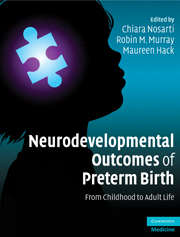Book contents
- Frontmatter
- Contents
- List of contributors
- Preface
- Section 1 Introduction
- 1 Epidemiology of preterm birth
- 2 The changing face of intensive care for preterm newborns
- 3 Clinical outcome: neurological sequelae following preterm birth
- Section 2 Neuroimaging
- Section 3 Behavioral outcome
- Section 4 Neuropsychological outcome
- Section 5 Applied research
- Section 6 Conclusions
- Index
2 - The changing face of intensive care for preterm newborns
from Section 1 - Introduction
Published online by Cambridge University Press: 06 July 2010
- Frontmatter
- Contents
- List of contributors
- Preface
- Section 1 Introduction
- 1 Epidemiology of preterm birth
- 2 The changing face of intensive care for preterm newborns
- 3 Clinical outcome: neurological sequelae following preterm birth
- Section 2 Neuroimaging
- Section 3 Behavioral outcome
- Section 4 Neuropsychological outcome
- Section 5 Applied research
- Section 6 Conclusions
- Index
Summary
Introduction
Neonatal intensive care has seen dramatic evolution over the last 50 years. It is natural for psychologists, therapists and developmental pediatricians to assume that “very preterm birth” represents an insult to the developing brain which is relatively constant and unchanging over time. In practice, continually varying trends, developments and fashions in neonatal care over the last 50 years have led to a constantly changing spectrum of insults and pathogenetic processes in the neonatal period. As a consequence, ex-premature survivors who are now entering adolescence and adulthood were exposed to forms of neonatal care which have become outdated and obsolete. A disturbing but recurrent theme over the last 50 years has been the considerable range of standard neonatal practices and therapies which have subsequently been found to lead to iatrogenic brain injury. An important task is to attempt to relate the pattern of neurological and developmental disorders associated with very preterm birth to the nature of care which was received in the neonatal period.
This chapter provides a brief and inevitably selective overview of developments in neonatal care for extremely preterm infants over the last 50 years, and discusses the mechanisms of brain injury in this vulnerable population. A number of more detailed sources on the history of neonatal care are available [1–4].
Neonatal care before 1965
The principles of care for premature babies were first laid down by Pierre Budin, Professor of Obstetrics in the University of Paris. The English edition of his book “The Nursling” was published in 1907 [5].
- Type
- Chapter
- Information
- Neurodevelopmental Outcomes of Preterm BirthFrom Childhood to Adult Life, pp. 17 - 29Publisher: Cambridge University PressPrint publication year: 2010
- 1
- Cited by



